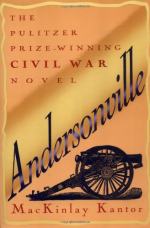To this smallness was added ineffable badness. The meal was ground very coarsely, by dull, weakly propelled stones, that imperfectly crushed the grains, and left the tough, hard coating of the kernels in large, sharp, mica-like scales, which cut and inflamed the stomach and intestines, like handfuls of pounded glass. The alimentary canals of all compelled to eat it were kept in a continual state of irritation that usually terminated in incurable dysentery.
That I have not over-stated this evil can be seen by reference to the testimony of so competent a scientific observer as Professor Jones, and I add to that unimpeachable testimony the following extract from the statement made in an attempted defense of Andersonville by Doctor R. Randolph Stevenson, who styles himself, formerly Surgeon in the Army of the Confederate States of America, Chief Surgeon of the Confederate States Military Prison Hospitals, Andersonville, Ga.:
V. From the sameness of the food, and from the action of the poisonous gases in the densely crowded and filthy Stockade and Hospital, the blood was altered in its constitution, even, before the manifestation of actual disease.
In both the well and the sick, the red corpuscles were diminished; and in all diseases uncomplicated with inflammation, the fibrinous element was deficient. In cases of ulceration of the mucous membrane of the intestinal canal, the fibrinous element of the blood appeared to be increased; while in simple diarrhea, uncomplicated with ulceration, and dependent upon the character of the food and the existence of scurvy, it was either diminished or remained stationary. Heart-clots were very common, if not universally present, in the cases of ulceration of the intestinal mucous membrane; while in the uncomplicated cases of diarrhea and scurvy, the blood was fluid and did not coagulate readily, and the heart-clots and fibrinous concretions were almost universally absent. From the watery condition of the blood there resulted various serous effusions into the pericardium, into the ventricles of the brain, and into the abdominal cavity.
In almost all cases which I examined after death, even in the most emaciated, there was more or less serous effusion into the abdominal cavity. In cases of hospital gangrene of the extremities, and in cases of gangrene of the intestines, heart-clots and firm coagula were universally present. The presence of these clots in the cases of hospital gangrene, whilst they were absent in the cases in which there were no inflammatory symptoms, appears to sustain the conclusion that hospital gangrene is a species of inflammation (imperfect and irregular though it may be in its progress), in which the fibrinous element and coagulability of the blood are increased, even in those who are suffering from such a condition of the blood and from such diseases as are naturally accompanied with a decrease in the fibrinous constituent.




